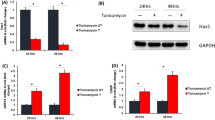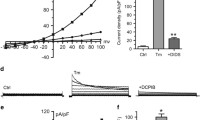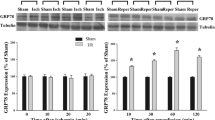Abstract
The heart is a very dynamic pumping organ working perpetually to maintain a constant blood supply to the whole body to transport oxygen and nutrients. Unfortunately, it is also subjected to various stresses based on physiological or pathological conditions, particularly more vulnerable to damages caused by oxidative stress. In this study, we investigate the molecular mechanism and contribution of IGF-IIRα in endoplasmic reticulum stress induction in the heart under doxorubicin-induced cardiotoxicity. Using in vitro H9c2 cells, in vivo transgenic rat cardiac tissues, siRNAs against CHOP, chemical ER chaperone PBA, and western blot experiments, we found that IGF-IIRα overexpression enhanced ER stress markers ATF4, ATF6, IRE1α, and PERK which were further aggravated by DOX treatment. This was accompanied by a significant perturbation in stress-associated MAPKs such as p38 and JNK. Interestingly, PARKIN, a stress responsive cellular protective mediator was significantly downregulated by IGF-IIRα concomitant with decreased expression of ER chaperone GRP78. Furthermore, ER stress-associated pro-apoptotic factor CHOP was increased considerably in a dose-dependent manner followed by elevated c-caspase-12 and c-caspase-3 activities. Conversely, treatment of H9c2 cells with chemical ER chaperone PBA or siRNA against CHOP abolished the IGF-IIRα-induced ER stress responses. Altogether, these findings suggested that IGF-IIRα contributes to ER stress induction and inhibits cellular stress coping proteins while increasing pro-apoptotic factors feeding into a cardio myocyte damage program that eventually paves the way to heart failure.





Similar content being viewed by others
Data availability
All the data are contained in the manuscript file and will be made available from the corresponding author upon reasonable request.
References
Wang S, Binder P, Fang Q et al (2018) Endoplasmic reticulum stress in the heart: insights into mechanisms and drug targets. Br J Pharmacol 175:1293–1304. https://doi.org/10.1111/bph.13888
Nakashima A, Cheng SB, Kusabiraki T et al (2019) Endoplasmic reticulum stress disrupts lysosomal homeostasis and induces blockade of autophagic flux in human trophoblasts. Sci Rep 9:11466. https://doi.org/10.1038/s41598-019-47607-5
Rashid HO, Yadav RK, Kim HR et al (2015) ER stress: autophagy induction, inhibition and selection. Autophagy 11:1956–1977. https://doi.org/10.1080/15548627.2015.1091141
Ji C (2015) Advances and new concepts in alcohol-induced organelle stress, unfolded protein responses and organ damage. Biomolecules 5:1099–1121. https://doi.org/10.3390/biom5021099
Vo DH, Hartig R, Weinert S et al (2019) G-protein-coupled estrogen receptor (GPER)-specific agonist G1 induces ER stress leading to cell death in MCF-7 cells. Biomolecules. https://doi.org/10.3390/biom9090503
Minamino T, Kitakaze M (2010) ER stress in cardiovascular disease. J Mol Cell Cardiol 48:1105–1110. https://doi.org/10.1016/j.yjmcc.2009.10.026
Tabas I, Ron D (2011) Integrating the mechanisms of apoptosis induced by endoplasmic reticulum stress. Nat Cell Biol 13:184–190. https://doi.org/10.1038/ncb0311-184
Gaballah HH, Zakaria SS, Elbatsh MM et al (2016) Modulatory effects of resveratrol on endoplasmic reticulum stress-associated apoptosis and oxido-inflammatory markers in a rat model of rotenone-induced Parkinson’s disease. Chem Biol Interact 251:10–16. https://doi.org/10.1016/j.cbi.2016.03.023
Li DL, Wang ZV, Ding G et al (2016) Doxorubicin blocks cardiomyocyte autophagic flux by inhibiting lysosome acidification. Circulation 133:1668–1687. https://doi.org/10.1161/CIRCULATIONAHA.115.017443
Octavia Y, Tocchetti CG, Gabrielson KL et al (2012) Doxorubicin-induced cardiomyopathy: from molecular mechanisms to therapeutic strategies. J Mol Cell Cardiol 52:1213–1225. https://doi.org/10.1016/j.yjmcc.2012.03.006
Sishi BJ, Loos B, van Rooyen J et al (2013) Autophagy upregulation promotes survival and attenuates doxorubicin-induced cardiotoxicity. Biochem Pharmacol 85:124–134. https://doi.org/10.1016/j.bcp.2012.10.005
Takemura G, Fujiwara H (2007) Doxorubicin-induced cardiomyopathy from the cardiotoxic mechanisms to management. Prog Cardiovasc Dis 49:330–352. https://doi.org/10.1016/j.pcad.2006.10.002
Hanf A, Oelze M, Manea A et al (2019) The anti-cancer drug doxorubicin induces substantial epigenetic changes in cultured cardiomyocytes. Chem Biol Interact 313:108834. https://doi.org/10.1016/j.cbi.2019.108834
Fu HY, Sanada S, Matsuzaki T et al (2016) Chemical endoplasmic reticulum chaperone alleviates doxorubicin-induced cardiac dysfunction. Circ Res 118:798–809. https://doi.org/10.1161/CIRCRESAHA.115.307604
Lou Y, Wang Z, Xu Y et al (2015) Resveratrol prevents doxorubicin-induced cardiotoxicity in H9c2 cells through the inhibition of endoplasmic reticulum stress and the activation of the Sirt1 pathway. Int J Mol Med 36:873–880. https://doi.org/10.3892/ijmm.2015.2291
Wang YX, Korth M (1995) Effects of doxorubicin on excitation-contraction coupling in guinea pig ventricular myocardium. Circ Res 76:645–653. https://doi.org/10.1161/01.res.76.4.645
Sag CM, Kohler AC, Anderson ME et al (2011) CaMKII-dependent SR Ca leak contributes to doxorubicin-induced impaired Ca handling in isolated cardiac myocytes. J Mol Cell Cardiol 51:749–759. https://doi.org/10.1016/j.yjmcc.2011.07.016
Hayashi T, Su TP (2007) Sigma-1 receptor chaperones at the ER-mitochondrion interface regulate Ca(2+) signaling and cell survival. Cell 131:596–610. https://doi.org/10.1016/j.cell.2007.08.036
Arola OJ, Saraste A, Pulkki K et al (2000) Acute doxorubicin cardiotoxicity involves cardiomyocyte apoptosis. Cancer Res 60:1789–1792
Chang RL, Nithiyanantham S, Huang CY et al (2019) Synergistic cardiac pathological hypertrophy induced by high-salt diet in IGF-IIRalpha cardiac-specific transgenic rats. PLoS ONE 14:e0216285. https://doi.org/10.1371/journal.pone.0216285
Pandey S, Kuo WW, Ho TJ et al (2019) Upregulation of IGF-IIRalpha intensifies doxorubicin-induced cardiac damage. J Cell Biochem 120:16956–16966. https://doi.org/10.1002/jcb.28957
Pandey S, Kuo WW, Shen CY et al (2019) Insulin-like growth factor II receptor-alpha is a novel stress-inducible contributor to cardiac damage underpinning doxorubicin-induced oxidative stress and perturbed mitochondrial autophagy. Am J Physiol Cell Physiol 317:C235–C243. https://doi.org/10.1152/ajpcell.00079.2019
Han K, Hassanzadeh S, Singh K et al (2017) Parkin regulation of CHOP modulates susceptibility to cardiac endoplasmic reticulum stress. Sci Rep 7:2093. https://doi.org/10.1038/s41598-017-02339-2
Wu KM, Hsu YM, Ying MC et al (2019) High-density lipoprotein ameliorates palmitic acid-induced lipotoxicity and oxidative dysfunction in H9c2 cardiomyoblast cells via ROS suppression. Nutr Metab (Lond) 16:36. https://doi.org/10.1186/s12986-019-0356-5
Lee CF, Chiang NN, Lu YH et al (2018) Benzyl isothiocyanate (BITC) triggers mitochondria-mediated apoptotic machinery in human cisplatin-resistant oral cancer CAR cells. Biomedicine (Taipei) 8:15. https://doi.org/10.1051/bmdcn/2018080315
Liu SP, Shibu MA, Tsai FJ et al (2020) Tetramethylpyrazine reverses high-glucose induced hypoxic effects by negatively regulating HIF-1alpha induced BNIP3 expression to ameliorate H9c2 cardiomyoblast apoptosis. Nutr Metab (Lond) 17:12. https://doi.org/10.1186/s12986-020-0432-x
Darling NJ, Cook SJ (2014) The role of MAPK signalling pathways in the response to endoplasmic reticulum stress. Biochim Biophys Acta 1843:2150–2163. https://doi.org/10.1016/j.bbamcr.2014.01.009
Tscheschner H, Meinhardt E, Schlegel P et al (2019) CaMKII activation participates in doxorubicin cardiotoxicity and is attenuated by moderate GRP78 overexpression. PLoS ONE 14:e0215992. https://doi.org/10.1371/journal.pone.0215992
Fu HY, Mukai M, Awata N et al (2017) Protein quality control dysfunction in cardiovascular complications induced by anti-cancer drugs. Cardiovasc Drugs Ther 31:109–117. https://doi.org/10.1007/s10557-016-6709-7
Hu J, Wu Q, Wang Z et al (2019) Inhibition of CACNA1H attenuates doxorubicin-induced acute cardiotoxicity by affecting endoplasmic reticulum stress. Biomed Pharmacother 120:109475. https://doi.org/10.1016/j.biopha.2019.109475
Funding
This study was supported by Grants from the China Medical University and Asia University, Taiwan. Grant numbers: [CMU107-ASIA-10]; [ASIA-106-CMUH-03].
Author information
Authors and Affiliations
Contributions
Conceptualization: SP; Data curation: YLY, WWK, and RJC; Formal analysis: CHK, YLY, and RJC; Funding acquisition: CYH; Investigation: SP; Methodology: SP; Project administration: TJH and CYH; Resources: TJH and CYH; Supervision: TJH and CYH; Validation: CYH; Writing—original draft: SP; Writing—review & editing: WSTC, CHD, and PYP.
Corresponding authors
Ethics declarations
Conflict of interest
The authors declare no conflict of interest exists.
Additional information
Publisher's Note
Springer Nature remains neutral with regard to jurisdictional claims in published maps and institutional affiliations.
Rights and permissions
About this article
Cite this article
Pandey, S., Kuo, CH., Chen, W.ST. et al. Perturbed ER homeostasis by IGF-IIRα promotes cardiac damage under stresses. Mol Cell Biochem 477, 143–152 (2022). https://doi.org/10.1007/s11010-021-04261-8
Received:
Accepted:
Published:
Issue Date:
DOI: https://doi.org/10.1007/s11010-021-04261-8




